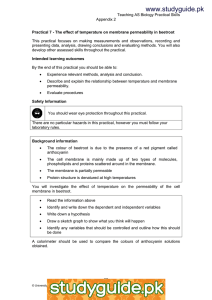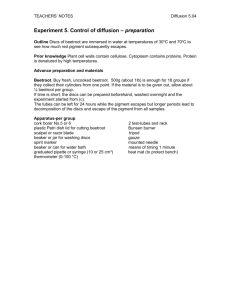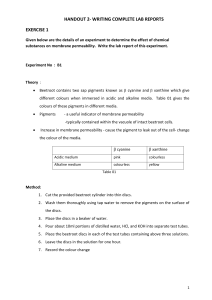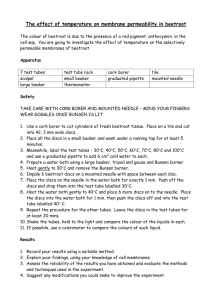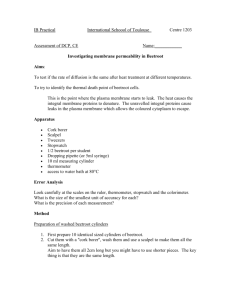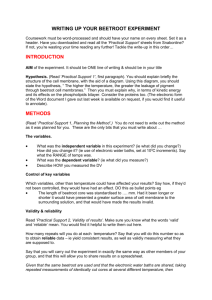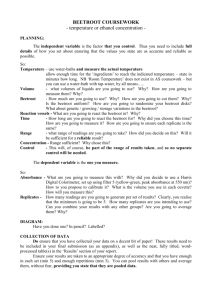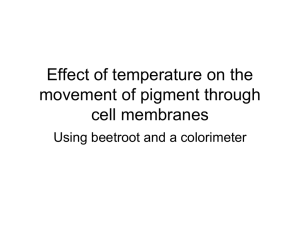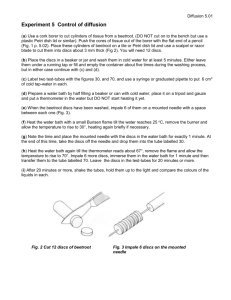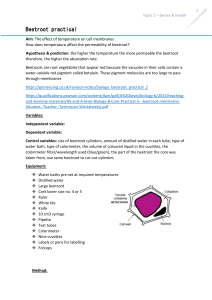www.XtremePapers.com
advertisement
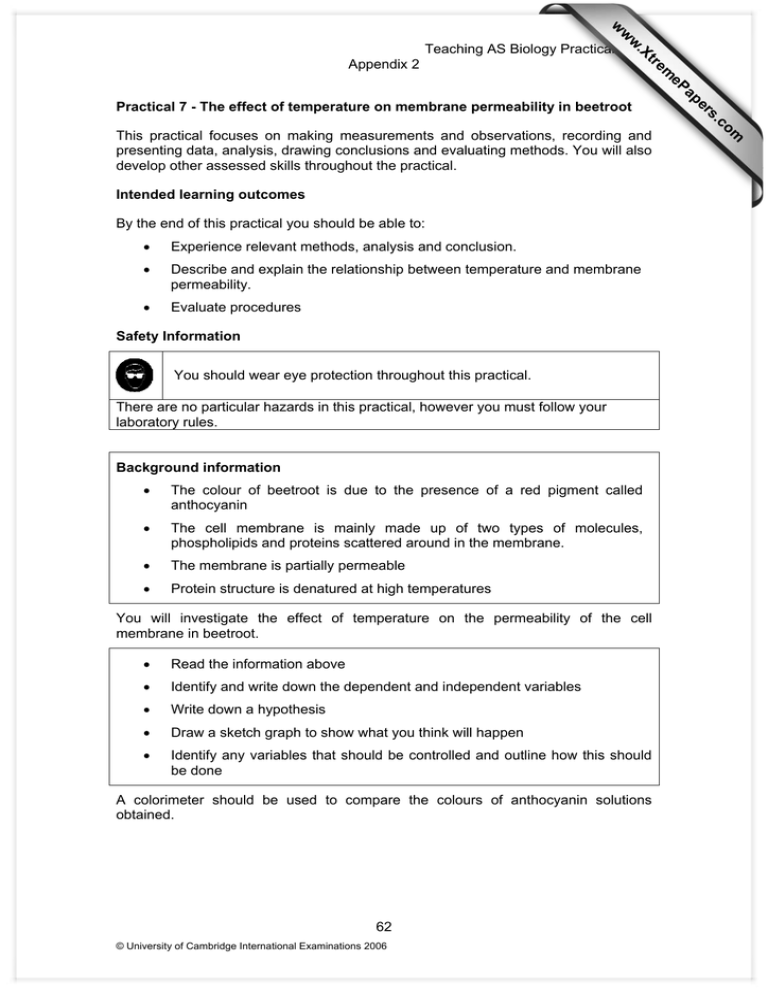
w w w Intended learning outcomes By the end of this practical you should be able to: • Experience relevant methods, analysis and conclusion. • Describe and explain the relationship between temperature and membrane permeability. • Evaluate procedures Safety Information You should wear eye protection throughout this practical. There are no particular hazards in this practical, however you must follow your laboratory rules. Background information • The colour of beetroot is due to the presence of a red pigment called anthocyanin • The cell membrane is mainly made up of two types of molecules, phospholipids and proteins scattered around in the membrane. • The membrane is partially permeable • Protein structure is denatured at high temperatures You will investigate the effect of temperature on the permeability of the cell membrane in beetroot. • Read the information above • Identify and write down the dependent and independent variables • Write down a hypothesis • Draw a sketch graph to show what you think will happen • Identify any variables that should be controlled and outline how this should be done A colorimeter should be used to compare the colours of anthocyanin solutions obtained. 62 © University of Cambridge International Examinations 2006 om .c This practical focuses on making measurements and observations, recording and presenting data, analysis, drawing conclusions and evaluating methods. You will also develop other assessed skills throughout the practical. s er Practical 7 - The effect of temperature on membrane permeability in beetroot ap eP m e tr .X Teaching AS Biology Practical Skills Appendix 2 Teaching AS Biology Practical Skills Appendix 2 Method Preparations and making observations 1. Use a cork borer to cut cylinders of fresh beetroot tissue. Place on a tile and cut into 30 discs, each 3mm wide. 2. Place all the discs in a small beaker and wash under a running tap for at least five minutes. 3. Label six test tubes – 30°C, 40°C, 50°C, 60°C, 70°C, 80°C. 4. Add 10cm3 cold distilled / de-ionised water to each tube. 5. Set up a water bath using a large beaker, tripod, gauze and Bunsen burner. 6. Heat the water gently until a temperature of 80oc is reached then remove heat source. 7. Take five of the beetroot discs and impale on a mounted needle with space between each disc. 8. Immerse the discs in the water bath for exactly one minute, then remove and carefully push the discs into the test tube labelled 80°C and set aside. 9. Reduce the temperature of the water bath to 70°C and take a second set of five discs and repeat the process of immersion for one minute followed by putting them into the next tube. 10. Continue the process for each of the temperatures. 11. After the discs have stood for thirty minutes shake the tubes and pour this liquid into a cuvette. 12. Fill a second cuvette with distilled water. 13. Place a blue filter into the colorimeter and use the distilled water to zero the machine adjusting the pointer to zero absorbance. 14. Measure the colour density of the 70°C solution. 15. Wash out the cuvette and repeat the procedure to record the light absorbance for each of the temperatures. Write-up • Record your results in a clear table ensuring units are put in headers where possible. • Plot a graph of relative concentration of pigment against temperature. • Explain your findings using your knowledge of cell membranes. • Assess the reliability of the results obtained and suggest any modifications you could make to improve the experiment 63 © University of Cambridge International Examinations 2006 Teaching AS Biology Practical Skills Appendix 2 Practical 7 - Lesson Plan The effect of temperature on the permeability of cell membranes Context A practical investigation set in the context of 9700 syllabus – cell membranes and the effect of temperature. Key aims of the lesson This practical is designed to develop the skills of observation, analysis and evaluation. Intended learning outcomes By the end of the practical and the write-up the student should be able to • Experience relevant methods, analysis, conclusions and evaluation. • Describe and explain the relationship between temperature and the permeability of cell membranes. Resources required White board or flipchart and suitable pens or blackboard and chalk Practical materials specified on the Technical Information Sheet. Copies of the student worksheets. Planned activities Timings/ minutes Teacher/ Student Activities End of previous lesson Preparation – 2 page student worksheet given out for students to read in preparation for the practical lesson. To consider identification of the variables, formulate a hypothesis and review previous learning on cell membranes 0-3 Introduction to the aims, intended outcomes and shape of the lesson – teacher led oral presentation 3-5 Context – review of cell membranes, key points written on board 5-8 Introduction to method – Teacher briefly outlines method and answers any student questions on procedure. Teacher emphasises safety concerns with cork borer (or sharp knife) and water baths 8 - 40 Carrying out the practical – students carry out the practical work. Whilst they are waiting for the 30 minute period they can write up the first part, identifying variables, hypothesis, results table. Teacher to demonstrate the use of colorimeter to those students unfamiliar with this piece of equipment. 64 © University of Cambridge International Examinations 2006 Teaching AS Biology Practical Skills Appendix 2 40 - 50 Obtain results – Students enter results into table and clear away apparatus as soon as they have finished 50 - 60 Drawing together the threads – Teacher led discussion on the skills that have been developed as well as discussion on results obtained. Practical write up to be completed in flowing lesson or as homework activity Useful information • For centres without access to a colorimeter the practical results will only be of a subjective nature. However the principles of denaturation of the proteins in the membrane can still be discussed and the pupils could evaluate to suggest improvements to include a more objective measurement. • If the centre has access to a number of thermostatically controlled water baths these could be substituted for the individual ones suggested in the method. Discussion / evaluation points should include: • explanation of the shape of the graph • consistency of the pigment within the beetroot • why the discs were washed before heating • possible problems with the method e.g. impaling onto a mounted needle • for students unable to obtain a full set of results the following could be used for analysis Temperature Absorbance / °C / arbitrary units 30 0.12 40 0.16 50 0.29 60 0.83 70 1.62 80 1.41 65 © University of Cambridge International Examinations 2006 Teaching AS Biology Practical Skills Appendix 2 Practical 7 - Technical information The permeability of beetroot cell membrane The apparatus and materials required for this practical are listed below. The amount of apparatus listed is for one student or one group of students if they are to work in groups. 1. fresh beetroot (each student requires a core approximately 10cm in length). 2. 6 test tubes 3. test tube rack 4. cork borer 5. white tile 6. scalpel 7. small beaker 8. 10cm3 graduated pipette or measuring cylinder 9. mounted needle 10. large beaker 11. thermometer 12. Bunsen burner 13. tripod 14. heat proof mat 15. gauze 16. colorimeter cuvettes (2) Additionally each student will require access to a sink, running water and a colorimeter. Safety Precautions/Risks. No specific hazards identified. A risk assessment should be carried out as a matter of course. 66 © University of Cambridge International Examinations 2006
